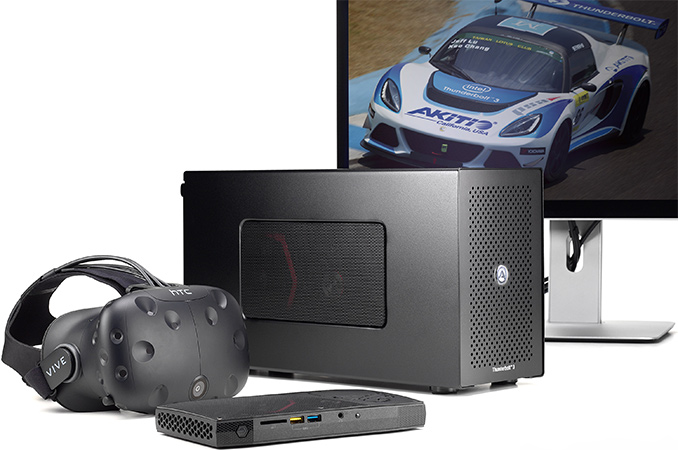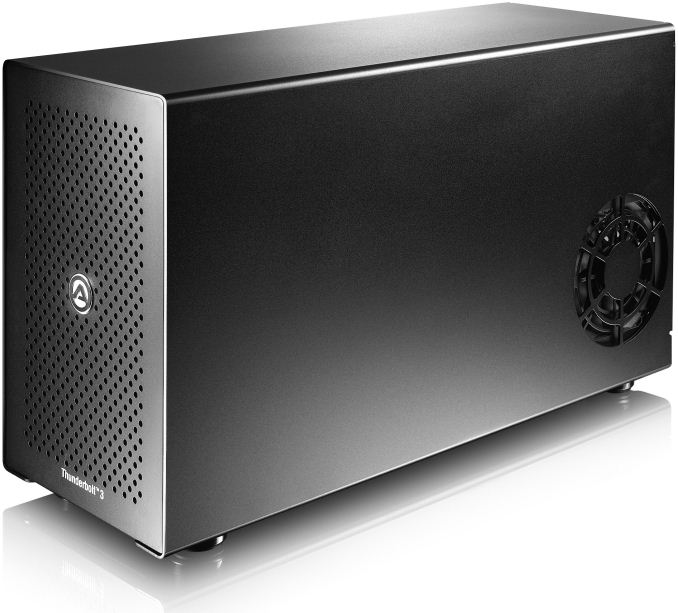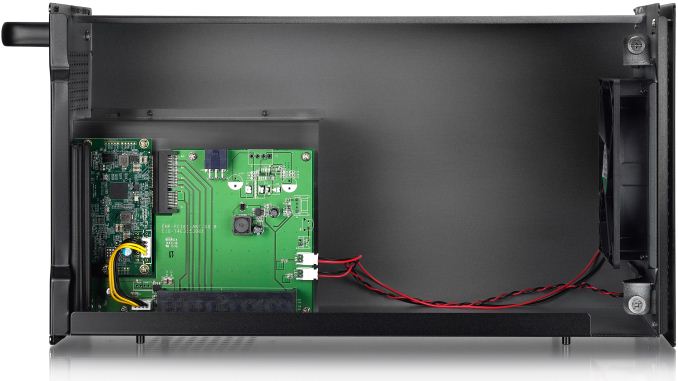AKiTiO Introduces Node: Thunderbolt 3 eGFX Box for $299
by Anton Shilov on November 14, 2016 4:50 PM EST- Posted in
- GPUs
- External GPU
- Thunderbolt 3
- eGFX
- Akitio
- Node

Over the past week AKiTiO has formally introduced its new external graphics enclosure using a Thunderbolt 3 connection. As with other external graphics enclosures, the AKiTiO Node allows a user to easily upgrade the graphics sub-system of notebook, AIO or SFF PCs that have a Thunderbolt 3 port by using a discrete graphics card. One of the key elements to eGFX is price and look, and AKiTiO has placed the Node at $299, but itcan fit graphics cards with massive coolers.
Enthusiasts started to experiment with external graphics over Thunderbolt 2 interface several years ago after multiple attempts of companies like ATI/AMD, ASUS and some others to develop commercial external GPU technologies had failed. Back in 2014, plugging a video card to a MacBook Pro using Thunderbolt 2 was costly: users had to buy a chassis for up to $1000 (there were cheaper methods, but they did not look solid), a PSU and a graphics board. The homebrew method worked, but had a number of limitations when it came to bandwidth, hot-plugging (more importantly, unplugging), driver support and some others, not to mention the aesthetics of such eGFX setups. Given the trend towards miniaturization of mobile and desktop PCs, the idea of external graphics was far too alluring to skip, which is why Intel decided to support it with its Thunderbolt 3 technology introduced in 2014. While technically TB3 is PCIe 3.0 x4 over a cable, to properly enable operation of external GPUs, Intel and its allies had to ensure support of eGFX hardware though operating systems, GPU drivers, firmware and so on. Earlier this year all pieces of the puzzle finally came together and the first “official” TB3 eGFX chassis were introduced by Razer and PowerColor.
While both Razer Core and PowerColor Devil Box do the job and even feature a couple of extras, they are rather expensive as they add more than just GPU features - $499 and $379, respectively. This week, AKiTiO, which has been offering external Thunderbolt enclosures for years, introduced its eGFX box that costs $299.99.
| AKiTiO Node (NODE-T3IA-AKTU) eGFX Chassis Specifications | ||||
| Max Video Card Size | Double-Wide, 12.2" Long (312 × 170 × 44 mm) |
|||
| Max Video Card Power | 300 W (?) | |||
| Connectivity | 1 × Thunderbolt 3 (>40 Gbps via active cable) | |||
| Chassis Size | 5.71 × 16.85 × 8.94 inches (145 × 428 × 227 mm) |
|||
| Internal PSU | 400 W SFX | |||
| System Requirements | Thunderbolt 3 eGFX Certified PC Thunderbolt 3 w/Active Cable (included) Windows 10 |
|||
| Shipping Date | December 2016 | |||
| Price | $299 | |||
The AKiTiO Node is a 42.8 × 14.5 × 22.7 cm (16.85 × 5.71 × 8.94 inches) box made of stainless steel that is compatible with a variety of double-wide full-length/full-height AMD and NVIDIA graphics cards (see the list here). The Node comes with an integrated 400 W SFX PSU (which means that it can be upgraded) as well as one 120 mm fan. As for dimensions, the Node seems to be a little more spacious inside than its rivals, which is good for cooling and compatibility with custom video cards (such as those from ASUS or EVGA). Despite this, GPUs with hybrid cooling (integrated liquid cooling) are not supported, such as AMD Radeon R9 Fury X.
| Comparison of Thunderbolt 3 eGFX Chassis | |||||||
| AKiTiO Node |
BizonTech BizonBox 3 |
PowerColor Devil Box |
Razer Core |
||||
| Chassis Dimensions | Length | 42.8 cm 16.85 in |
36 cm 14.17 in |
40 cm 15.748 in |
34 cm 13.38 in |
||
| Height | 22.7 cm 8.94 in |
20.5 cm 8.07 in |
24.2 cm 9.52 in |
21.84 cm 8.6 in |
|||
| Width | 14.5 cm 5.71 in |
8 cm 3.5 in |
17.2 cm 6.77 in |
10.5 cm 4.13 in |
|||
| Max Dimension of Compatible Graphics Card | Length | 31.2 cm 12.2 in |
|||||
| Height (PCB+Cables) |
17 cm 6.7 in |
over 14" over 5.51" |
14 cm 5.51 in |
15.2 cm 5.98 in |
|||
| Width | 4.4 cm 1.73 in |
5 1.96 in |
4.4 cm 1.73 in |
||||
| Maximum GPU Power | 300 W (?) | 375 W | |||||
| PSU | Wattage | 400 W | 200W/400W | 500 W | |||
| Form-Factor | SFX | external | internal proprietary | ||||
| Cooling Fans | 1 × 120 mm | 2 × 60 mm | unknown | 3 × 80 mm | |||
| Connectivity | Thunderbolt | 1 × TB3 | 2 × TB3 | 1 × TB3 | |||
| Ethernet | 1 × GbE | ||||||
| USB | - | 4 × USB 3.0 | |||||
| SATA | - | 1×SATA 6Gb/s | - | ||||
| DisplayPort | - | 1 × DP 1.2 | - | ||||
| Availability | December 2016 | October 2016 | April 2016 | ||||
| Price | $299 | $649 | $379 | $499 | |||
Unlike competing products, the AKiTiO Node is a pure external GPU box and nothing more. It does not have extra USB 3.0 ports (to connect a VR headset, for example), a GbE controller nor a SATA connector. This naturally cuts down its costs and allows Akito to sell the eGFX enclosure at $299 price-point, but additional USB ports will be greatly missed by owners of ultra-thin laptops as well as SFF PCs.
AKiTiO plans to start selling the Node (NODE-T3IA-AKTU) in December.
Source: AKiTiO


















56 Comments
View All Comments
ingwe - Tuesday, November 15, 2016 - link
Excited that the prices are coming down but they aren't there yet in my opinion. Once these hit $150, I think that is where I start considering getting rid of my desktop.Guspaz - Tuesday, November 15, 2016 - link
It's nice that they continue to come down in cost, but there's still nothing to address a less "extreme" market segment. This thing is still huge, rather expensive, and overkill for something like a 970/1070. The 170 has a TDP of 150W, half of what this enclosure is designed for.It'd be nice to see an external enclosure that was designed to take a standard sized upper midrange card, because not everybody who wants extra power for their NUC or laptop wants to run a Titan X.
Andromedus - Tuesday, November 15, 2016 - link
I have to say I'm a bit surprised at many of the posters complaining about the price point. I can only assume these people haven't been following this tech for long. The BizonBox starts at $599 and "offers" a few ports that will bottleneck an already bandwidth-starved GPU. The Razor Core is $499 and suffers the same issues. This is $200 cheaper and all of its bandwidth will be going where it's needed.It's important to keep in mind just what this $300 purchase unlocks for the consumer, and comparing it to the cost of buying a tower PC completely misses the point. Many people have a need for the portability that a laptop offers, and also need the beefier capabilities of a desktop GPU when at their desk. $300 provides all of the tower components one would need - minus obviously the typically expensive GPU.
This means that the laptop may supply the desktop equivalent of the monitor, keyboard, peripheral hub/motherboard, wifi card, sound card/speakers, ram, hard drive(s), optical drive(s), webcam, and so forth. Enabling your laptop to provide all of that for your desktop is not a bad deal at $300, particularly if your laptop sports medium to high end hardware.
Adding to this is the fact that the laptop itself will avoid obsolescence much longer due to the upgradeability of the eGPU.
Both of these arguments combine to create a very compelling rationale for this product at $300 for a wide - albeit niche - audience. Take for example the Acer V17 Nitro Black, available for only $1200 at Costco (no affiliation): http://www.costco.com/Acer-V17-Nitro-Laptop---Inte...
For a very compelling $1200 price-point it offers a true 4k screen at a desktop-worthy 17" size. It also sports Thunderbolt 3. It offers a capable 4 GB GTX 960 for on-the-go use and an Intel Core i7-6700 HQ, along with 16 GB DDR4 Ram. Because it is unlikely to function well at 4k resolution with most games, it may be scaled to 1080p during mobile use, and 4k resolution any time an eGPU is attached. Future-proofing is essentially achieved, and the 4k resolution may be scaled back to 1080p long into the future when advanced games or other media programs begin to strain it even with the eGPU.
That's not mentioning that the owner's next laptop, when replacement becomes necessary, need not put much emphasis on the stock mGPU’s power, as the Node will provide the horsepower needed when heavy-lifting is a must. This fact saves the buyer considerable expense far into the future.
Anyone seeking the appropriate system configuration can take advantage of this product and recoup their $300 if they make intelligent, strategic choices.
There is no question that eGPUs are the future, as is the much wider umbrella of modular, plug-n-play computing. $300 puts this well into the reach of the mainstream, so long as the niche prerequisites that make it attractive are met.
1_rick - Thursday, November 17, 2016 - link
"Many people have a need for the portability that a laptop offers, and also need the beefier capabilities of a desktop GPU when at their desk. "An important additional component in the consideration is "and you don't want to have two PCs".
Impetuous - Monday, November 21, 2016 - link
If used with a desktop, does the installed GPU just appear as another display device to the OS? My interest is more in expanding the compute capability of my existing machine.Nunyabz - Friday, December 2, 2016 - link
If your desktop has thunderbolt 3 you should be able to use it for a second/additional display.